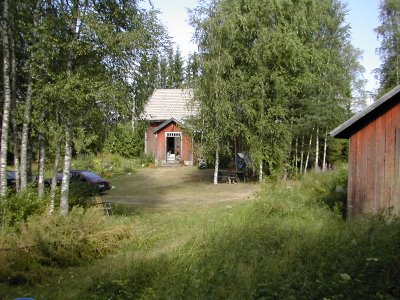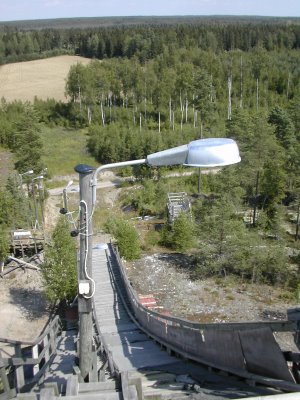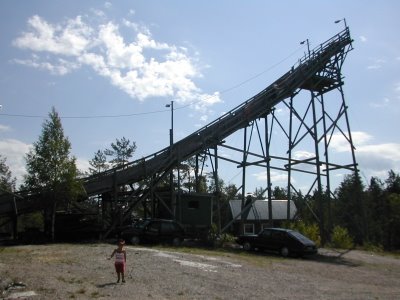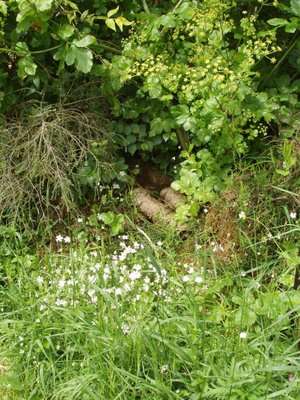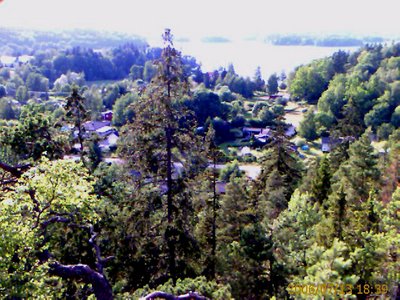
I've never been to a real rock festival, and I must say that I find the idea unattractive. I mean, living in tents, makeshift toilets, mud... Not to mention the fact that several days of non-stop rock concerts sounds like a nasty chore. But I do like urban mini-festivals, which allow me to hear several bands in a few hours and then go home. Last night I attended the Accelerator mini-festival in Stockholm, and I had a great time. So many talented, innovative, hard-working musicians! I am in awe!
The festival was in the old converted Munich brewery near the terminal of my commute train line. (This happens to be the venue where I heard Mercury Rev in 1999, approached a girl unsuccessfully, ended up talking with her friend instead, and the friend later invited me to a party, where I picked up this hot Chinese girl, and we just celebrated our seventh anniversary. But I digress.)
Much of the festival premises were under open sky, it was a beautiful evening, and the brewery is on a hillside overlooking
Riddarfjärden, "Bay of the Knights". So there was a nice view quite apart from that of the sun-tanned and summery attendees.
I heard hour-long concerts with six bands. (I just can't bring myself to saying "I saw a band". That expression always makes me want ask, oh, really, what where the band members doing when you saw them? Having lunch? Shopping for undies?) All are centred on standard guitar-pop quartets, some with various extensions.
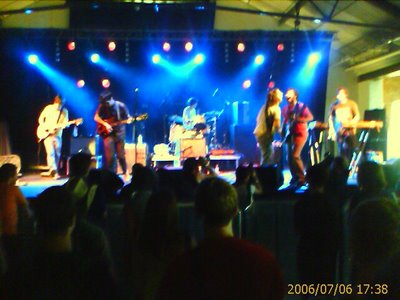
The
Spinto Band from Delaware were new to me. All I'd heard of them before were four songs from their 2005 debut album
Nice and Nicely Done, but I was already enthusiastic. New-wavy psychedelia with a lot of harmony singing. They're a college boy six-piece, the basic quartet augmented with keyboards and an extra guitar, and mandolin on some songs. Turns out they're a sight to see as well: The Spinto Band do choreographed rhythmic spazzing. Yep, the front men move as if they suffered from cerebral palsy, in time with the music. And to one side, the portly keyboard player gazes out over the proceedings with a beatific, baffled smile as he sings "ooooh, aaaah". One of the front men, by the way, looks, moves, dresses and sings like a young David Byrne.
Apart from their own very strong material, the band covered Tiffany's "I Think We're Alone Now" from 1987 and The Motors's "Airport" from 1978. The Spinto Band are highly skilled musicians and composers, but they're also clowns, and everything they do seems tongue in cheek. Keep them in mind for the future.
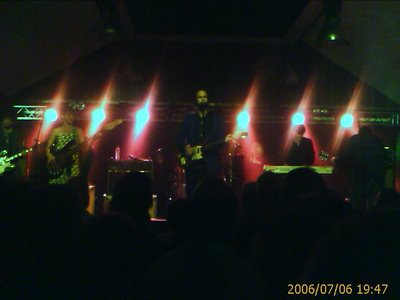
From quirky exuberance I went straight to Johnny Cash Land to listen to the
Silver Jews from Nashville, Tennessee. They are a six-piece too with the same instrumentation as the Spinto Band's, but that's as far as the similarity goes. The Jews are touring with their fifth album, 2005's
Tanglewood Numbers, recorded after the band leader almost died from depression and substance abuse. He cut a striking figure last night, a tall emaciated man with a black beard, like a mournful prophet straight out of the Old Testament. But his wife is really cute and plays a mean bass, so I think he's probably happier now. And they have a really good lead guitarist. I liked them much better live than I did in headphones.
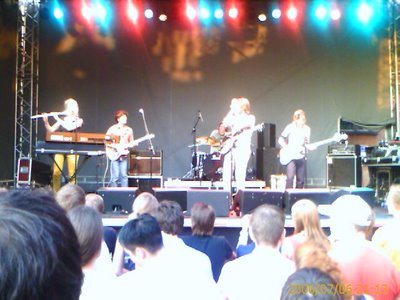
Then, aah, one of the bands that made me buy a ticket: the
Essex Green, from Brooklyn, NY. Pure power-pop bliss. They're a basic quartet plus a keyboardist who also plays the flute. Heart-rending girl-boy harmony singing. I heard them in Stockholm two years ago, and since then they've put their old touring bass player behind the drums and stolen The Ladybug Transistor's bass player. Great band, great show as the sun went down, sheer joy.
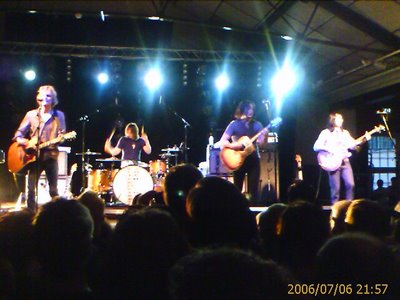
As the evening cooled down, the big names played. First the
Raconteurs from Nashville. I've written about them here
before: they're a supergroup with Jack White of the White Stripes and Brendan Benson of solo fame as front men, a basic quartet plus a touring keyboard player.
Like most bands, the Raccoon Turds rock more heavily on stage than in the studio. They made a point of startling us into submission with a furious intro. White is really larger than life, sings and plays the guitar like a man possessed. This makes a funny contrast to the extreme poker face of the bass player, who by the way plays a semi-acoustic bass. I'd have liked to hear more of Benson's love of melody, but still, great band, great gig. I'm glad I was there.
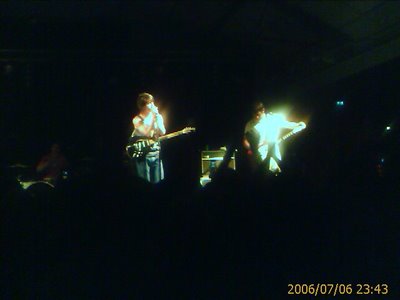
A band that deserves the hype they ride on is the
Arctic Monkeys. Neo-post-punk sung by teenagers in a grating Sheffield accent may not be for everyone, but the Monkeys have authority far beyond their years. A very tight and hard-rocking classic quartet. They reminded me of The Jet, poor bastards, who haven't been able to put out a second album because of touring with Oasis,
shudder.

The evening ended after one o'clock with another band I'd never heard of before: the
Islands from Montréal, Quebec. Their debut album
Return to the Sea was released in April. It's ambitious, soft progressive psychedelia, some of it a bit turgid, but with a great tracks too. Their performance yesterday was surreal. For the moment, the constantly changing band was a seven-piece including a basic quartet and keyboards, but the members also kept switching instruments among violin, bass clarinet, even oboe. A lot of different skin colours were represented, and one of the violinists and singers was a girl of a very tender age, right off the scale on the
avuncularometer. Everybody wore white, and the unsmiling front man had a necklace of plastic bones. I think the audience was a bit apprehensive at first, but the band won us over and everybody was happy. They made the most use of dynamics of all the bands on that guitar-soaked night, I had to remove and replace my earplugs repeatedly. I'll definitely check these weird Canadians out some more.
Between acts, I also heard a few songs each by Swedish teenie twin-sister duo Taxi, taxi!, American Lydia Lunch follower Josephine Foster, British folkies King Creosote and British electro collective Hot Chip, and they all had some very good things to offer. Live music is magic! But it's got to be in small venues like last night, where Jack White can pour water on you and you can study the drummers' amusing facial expressions.

Because I didn't want to hang around waiting for a bus, it took me an hour and a half including a long solitary walk to get home. But I listened to the Fiery Furnaces on my pocket computer, saw the first touch of rosy-fingered Eos on the northern (!) sky and took a nice pic, so I'm happy anyway. Just a little tired.
[More blog entries about music, pop, rock, festival, Sweden; musik, rock, pop, festival, stockholm.]



